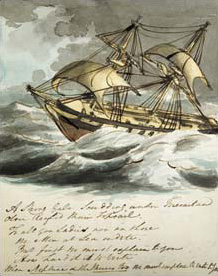HMS Clio (1807)

Sketch of a brig-sloop, probably HMS Clio, by Cmdr. William Farrington, ca. 1812, Peabody Essex Museum
|
|
| History | |
|---|---|
| Name: | HMS Clio |
| Namesake: | Clio |
| Builder: | James Betts, Mistleythorn |
| Launched: | 10 January 1807 |
| Commissioned: | February 1807 |
| Decommissioned: | 1816 |
| Recommissioned: | February 1823 |
| Decommissioned: | 1845 |
| Fate: | Broken up, 1845 |
| General characteristics | |
| Class and type: | Cruizer-class brig-sloop |
| Tons burthen: | 389 35⁄94 (bm ) |
| Length: |
|
| Beam: | 30 ft 9 in (9.4 m) |
| Depth of hold: | 13 ft 11 in (4.2 m) |
| Sail plan: | Brig |
| Complement: | 121 |
| Armament: |
|
HMS Clio was Cruizer-class brig-sloop of the Royal Navy, launched at James Betts' shipyard in Mistleythorn on 10 January 1807. Her establishment was 71 officers and men, 24 boys and 20 marines. She served in the Baltic during the Napoleonic Wars, accomplished the re-establishment of British rule on the Falkland Islands in 1833, and participated in the First Opium War. She was broken up in 1845.
In February 1807 Commander Thomas Folliott Baugh commissioned her and sailed her to the Leith Station on the North Sea. Here he succeeded in taking several prizes, but not until 1808.
The first appears to have been the Helyra, Hook, master, from Bergen, which Clio sent into Leith in July. Then on 21 September 1808, while she was cruising off Fleckoro, Clio captured a small Danish privateer armed with six guns and carrying a crew of eleven men. The captured vessel arrived at Leith on 12 October.
On 7 December she captured the Vrouw Heltya.
On 30 March 1808, during the Gunboat War, Clio entered Tórshavn, the capital of the Faroe Islands, and briefly captured the fort at Skansin. The fort surrendered without firing a shot as the landing party approached. The landing party spiked the fort's eight 18-pounder guns and took all the smaller guns and weapons before leaving. Shortly after, on 6 May, a German privateer who had assumed the name "Baron von Hompesch" plundered the defenceless city and seized the property of the Danish Crown Monopoly. The Admiralty Prize Court, however, refused to condemn it as a lawful prize. Later, after the Jørgen Jørgensen affair (see also HMS Talbot), Britain declared the Faroese, the Icelanders, and the settlers in Greenland as "stranger friends" who were to be left in peace.
...
Wikipedia
